| The summer of
2000 saw many members of Clan Carmichael USA traveling to Scotland for
the Millennium Gathering of Clan Carmichael on the Carmichael estate
near Biggar in Lanarkshire. Hosted by our Chief, Richard Carmichael of
Carmichael, 26th Baron and 30th Chief, and his
Lady, this was the 6th international gathering of the clan.
Previous gatherings were held in 1983, 1986, 1990, 1993, and 1996. The
Carmichaels at the Gathering came from France, Holland, England,
Scotland, Australia, New Zealand, the United States and Canada. As well
as the Pierre Carmichael family, residents in France for 150 years,
there were Carmiggelts (another form of Carmichael) who have resided in
Holland from the 1599 arrival of Robert Carmichael the Armourer, and
descendants of the first Carmichaels in America in 1649.
The weather cooperated beautifully as we
gathered on Wednesday, June 28, for a welcome dinner featuring
Carmichael meats at the Tinto Hotel in Symington. There were 140
international clan members in attendance. The following day clansmen met
at the Discover Carmichael Visitor Centre off of the A73 highway. A gift
shop, restaurant, historical wax museum, and play area are part of the
Centre. Here, after an address by the Chief, some followed the Chief on
an energetic walk over the estate, touring the historic sites. First,
the hike led to Chester Hill to view the Iron Age Roman fort and
Blackshouse burn Neolithic site. Then they walked to the original Eagle
Gate, through the present Eagle Gate and up to Kirkhill. Thirdly, the
really difficult hike to Carmichael Hill to see the Hyndford Monument
saw our enthusiastic Chief taking the shorter steep path to the top
rather than the regular path taken by vehicles. The tour then took the
group to Westmains then to the Carmichael Kirk. This hike, which became
known as a death march for most clan members involved, took 3 1/2 hours.
For those not inclined or able to hike, van transportation was provided
to each site where a guide explained the history and answered questions.
We first visited Kirkhill, site of the original hill fort and the church
dedicated to St. Michael by Queen Margaret around 1070 A.D. The hill
fort ‘caer’ and the church of St. Michael gave us our name of
Carmichael. The mausoleum where several former chiefs are buried is on
Kirkhill. From here we went to the ruins of the Carmichael mansion which
was built in the 1700s by the Earl of Hyndford, known as the Great Earl
because of his many improvements to the estate while at the same time
serving his country as an ambassador overseas. The roof was removed from
the mansion in the 1950s so taxes wouldn’t have to be paid on the
building. What remains is gutted out in preparation for restoration.
International clan members have donated money towards that restoration,
and the walls are now in good repair. A new fund has been started to
help put a new roof on the buildings. Several of us walked through the
pine woods, past the pet cemetery, toward Westmains, home of the current
Chief and his family. The woods are very green with fern glades and
small wildflowers, evidences of a stone wall and former garden, and a
lovely arching bridge. At Westmains, we toured the dovecot and the Chief’s
dining room and sitting room, and then followed the tartan carpet up the
stairs to see the four-poster bed with the coat of arms carved on the
footboard. The garden was colorful with flowers, many surrounding the
Hyndford Horse, which sits at the centre of the courtyard. Our touring
concluded at the Carmichael kirk where there is a Carmichael stained
glass window. Several items from the original church on Kirkhill have
been incorporated into this church. The Carmichael School is nearby.
After lunch in the Visitor Centre restaurant, a tour was provided to the
privately owned medieval Carmichael mill site. This well-preserved
historic site has had several other uses throughout history. It was once
used for smelting, and the bell used in the Carmichael Kirk was cast
here. Clan Carmichael USA held its annual meeting this evening prior to
dinner. At this time our Chief was presented a history album scrapbook
detailing the 17 years since the formation of Clan Carmichael USA. A
murder mystery dinner was our entertainment this evening at the Tinto
Hotel. No one solved the mystery, but there was much laughter at the
guesses as to who was the guilty party.
Friday morning saw the clansmen boarding
three coaches for a tour to Jedburgh where we toured the Jedburgh Abbey
ruins and the Mary Queen of Scots house. The Four Marys stayed in this
house with the Queen, and her Carmichael half brother and sister visited
her here. It was a dreary day today with rain threatening at any moment,
but it never materialized. The gloom outside only made the colors of the
roses in the garden of the house show up more brilliantly against the
green of the grass and the gray stone walls. We then went to the
Jedburgh Woolen Mill for lunch and shopping. Carmichael tartan items
were featured prominently as we entered the shop. Our afternoon
excursion took us to Traquair House, the oldest continuously inhabited
house in Scotland. Our Chief disappeared down the priest’s hole and
although several tried to follow, he was never found and the others had
to return to the priest’s room to descend to the ground floor in a
more normal way. This house has a very narrow stairway with uneven
steps, some very shallow and some very high, which makes it difficult to
ascend quickly. This was done purposely so one’s enemies couldn’t
pursue easily. There is a large rope along one side that one must hold
to help in ascending. Several of us had to try this staircase even
though there was an easier staircase farther along the hallway. We
returned to our hotels with just time enough to change clothes before
the dinner that night. Following the dinner there was a family ceilidh,
which provided much hilarity. Clan members performed in skits, sang,
played the clarsach (Scots harp), and gave recitations.
On Saturday the sun was shining as we
gathered at Eastgate, site of the original gates of the estate. From
there we marched as a clan to Eagle Gate, the present gate to the estate
just off of the A73 highway. Two pipers followed by the Chief and his
Lady, the standard bearers, honour guard, musketeers, and clansmen, now
about 200 persons, marched to the gates where the eagles were unveiled
and rededicated. They were stolen in August 1997 along with two
pineapples. The eagles were found in a ditch in central Scotland in
February 1999 but the pineapples have never been found. After
restoration, the eagles were now being returned to their proper place at
the entrance to the Carmichael estate. The Clan USA newsletter is named
The Eagle Gate. From the gates, the clan marched to Kirkhill where the
Chief addressed the group. From Kirkhill, the clan marched on to the
Carmichael mansion ruins. Here the Chief unveiled a plaque listing the
names of those who contributed to the wall restoration project. The
Chief and Lady Patricia were presented flowers here to thank them for
all of the work they had put in to planning and hosting this gathering
and to commemorate Richard’s 20th year as Chief. He is
beginning his 20th year, but the clan won’t be gathered at
the actual date next year, so we decided to say thank you as a group
this year. The gathering group picture was taken in front of the ruins
after much confusion as to who was going to be in the picture and who
was going to take the picture. At one point, half of the group was in
the picture and the other half was across the way taking the picture!
Our Chief showed his leadership skills in sorting everyone out,
designating a photographer, and getting everyone else in place. The clan
then marched to the marquee lunch in the walled garden with a pipe band
playing as we ate. The Earl of Loudoun’s Regiment of Foote provided a
living history battle reenactment. This was followed by games including
a haggis toss, tug of war, kilted mile, and football. After dinner this
evening, there was a fantastic tartan ball with the Lismore Ceilidh Band
providing Scottish country dance music. The band leader gave the dance
instructions and many members who had never done the dances before gave
it a try. It was all in good fun, and since they were among family no
one worried about making a fool of himself.
On Sunday morning the tartan-clad clan
attended church at the Cairngryffe Church in Carmichael. Lady Patricia
and Chief Richard read the lessons. After the sermon, Kathy Gambill,
clan member from Indiana, USA, stood beneath a stained glass window in
front of the communion table and sang a beautiful song called "I Am
A Servant." Two Carmichael marriages were then blessed. The
conclusion of the service was also the conclusion of the Millennium
Gathering of Clan Carmichael. Everyone thanked and applauded our Chief
and his Lady for all of their efforts to make this the best clan
gathering yet. After hugs and farewells to our Carmichael
"cousins", a coach returned some clan members to Glasgow
Airport while a large van returned others to Edinburgh Airport. Some
clan members stayed on to further tour Scotland.
Prior to the Clan Gathering itself, 70
international clan members had gone with the Chief and his Lady on a
battlefield and origins tour to Cornwall and France. A coach took the
group from Carmichael on Monday, June 19, to Penzance in Cornwall,
England. As with many family outings, the departure was delayed by
someone who forgot his passport at the hotel. The next day the group
visited St. Michael’s Mount where they had lunch and were escorted by
Lord St. Leven around his island home. Dinner that night was in Plymouth
before sailing overnight to Roscoff, France. The first rain of the tour
arrived while the group was dining, and the weather change caused some
turbulence while crossing the English Channel. The ferry pitched and
rolled making sleep difficult. Lunch the following day was at Mont St.
Michael where they toured the Abbey and stayed overnight in the medieval
town. Here they met Pierre Carmichael and his family. Pierre had a
notebook tracing his family back to the estate in Scotland. On Thursday,
the group visited the Bauge Battlefield where in 1421 we won our Arms
when a Carmichael ancestor broke his spear unseating the Duke of
Clarence, brother of the king of England. The Duke was then killed and
the battle was won against England. This battle was a very significant
event in the Hundred Years War. It was the first victory the French had
had over the English and was the turning point, which led to eventual
French defeat of the English. The broken spear is part of our Carmichael
clan badge and is the name of the international newsletter published by
our Chief. Historian Jean Renard explained the battle to the group. Our
Chief laid a wreath commemorating Scots and French dead then gave a
speech in French thanking the two local mayors and the Alliance France
Ecosse for their welcome. Lunch was hosted by the two mayors and lasted
about 3 hours. Afterwards, the group made a short detour into Bauge
where the museum was opened for them to see a painting of Sir John
Carmichael at the Battle of Bauge.
The group then traveled to Orleans to see
the walled city and cathedral where our warrior priest forebearer,
Bishop de Saint Michael, helped Joan of Arc defend the city in 1429-30
and dedicated a Masse Eccossais to the Scots dead. Julian Hutchings from
the Alliance France Ecosse escorted the Carmichaels in Orleans giving
insight into the Scots history at the time of Joan of Arc. The group
also visited the house and room where Mary Queen of Scots’ first
husband died after a jousting accident with the leader of the Scots’
Guard. The accident left a broken spear point in his eye. Queen Mary’s
Carmichael half brother and sister also had been there. From Orleans the
route took the group through Paris, giving a glimpse of the Eiffel Tower
in the distance, then on to Calais where they stayed overnight at the
Holiday Inn.
The tour ended with a return to Scotland
from Calais and the channel tunnel then coach on Sunday, June 25. In one
spectacular week with beautiful weather throughout, the core of our name’s
Archangel origins had been traced.
Following the tour and gathering, the
accolades poured in with many saying this had been the opportunity of a
lifetime. We know of no other Scottish clan chief who provides a similar
experience for his clan. He leads our global clan by example with fun,
history, authentic heritage, and strong family values. With each
previous gathering our Chief has organized a tour of various parts of
Scotland showing us the history and beauty of the country. He believes
that "families who play together stay together." One observer
described our joint activity as "Carmichaeling." We hope to do
much more Carmichaeling in coming years and urge all other Carmichaels
to join us. |
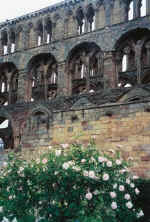
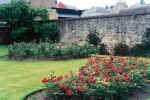
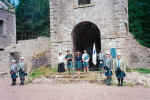
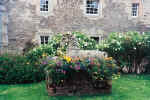
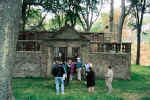
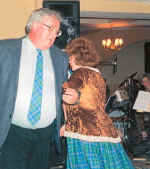
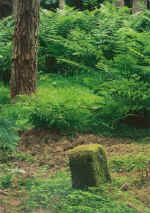
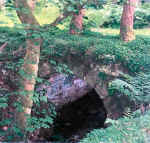
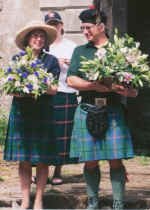
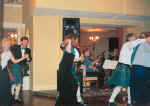
Thanks to
John Carmichael
for these next photographs
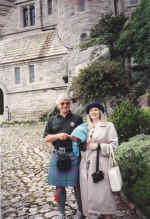
Chief Richard Carmichael of Carmichael
and Margo Carmichael of Arizona pose before the castle atop St.
Michael's Mount in Cornwall, England, which, like the name Carmichael,
honors the archangel St. Michael.
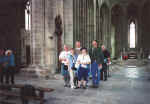
Chief Richard Carmichael (left) and some of
his clan at Mont St. Michel in Normandy. The island is also named for
the archangel St. Michael.
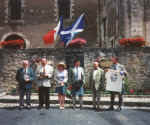
Ceremony at Vieil Bauge, France, honoring
Chief
Richard and Lady Patricia Carmichael and their clan, and unveiling a
commorative plaque from the Alliance France Ecosse. On March 22, 1421,
Sir John Carmichael, Richard's ancestor, led the combined Scots/French
Army to victory here by unhorsing the English Commander Thomas, Duke of
Clarence and brother of Henry V. For this deed, he was awarded the
Carmichael Arms depicting a broken spear.
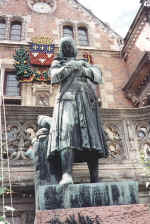
Statue of St. Joan of Arc in Orleans,
France. Sir John Carmichael and his fellow Scots supported her troops
against the English Army of Henry V.
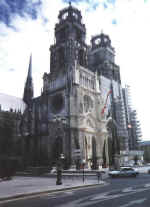
Cathedral of St. Croix in Orleans, France,
where John Carmichael was Bishop of Orleans at the time of Joan of Arc's
defense of the city.
|

